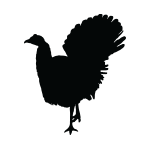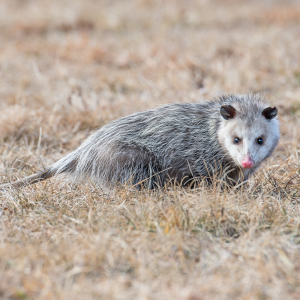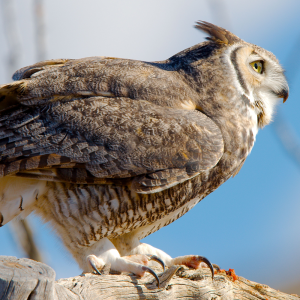PHYSIOLOGY | IMAGES | ETYMOLOGY | TAXONOMY | GEOGRAPHY | BEHAVIOR | DIET | REPRODUCTION | ECOLOGY | CONSERVATION | FAUNAFACTS | VIDEO | SOURCES

The ocellated turkey is the smallest of the world’s two species of turkey. It was named for the spots on its metallic and colorful tail feathers and was speculated to have been a close relative to the peafowl because of the resemblance in appearance. This colorful bird is endemic to the Yucatan Peninsula of North America.
Physiology
Ocellated turkeys vary from the wild turkey (Meleagris gallopavo) by size, the lack of a chest tuft and wattle, and the color of the bare skin of their heads, blue instead of red.
The ocellated turkey is the smallest species of turkey and is significantly smaller than any of the five subspecies of wild turkey. Ocellated turkeys are roughly two thirds the size of the other species of turkey with adult hens weighing approximately 8 pounds just prior to egg-laying and nesting and about 6-7 pounds the remainder of the year. During the breeding season adult males weigh approximately 11-12 pounds.
Both sexes of the ocellated turkey have a fleshy blue crown or knob behind the snood on the head which is adorned with distinctive caruncle-like growths, called nodules, that vary in shades of yellow, orange, red, and coral similar to those on the neck. The nodules are more pronounced on males. The turkeys also have a distinct eye-ring of bright, red-colored skin, especially visible on adult males during the breeding season.
The tail feathers in both sexes of the ocellated turkey are bluish-gray in color with a well defined, blue-bronze, eye-shaped spot near the end, followed by a bright gold tip. The ocellated turkey’s upper, major secondary wing coverts, or wing bar, are a rich copper color and highly iridescent. It may be possible to age male ocellated turkeys based on the width of the rich copper band on their wings as adults of both sexes appear to have wider bands, but more research is needed to confirm this trait. This method probably isn’t totally reliable for females after the first year.
Like wild turkeys, leg lengths of the ocellated turkey differ between sexes. Average leg length for females is less than 5 inches as compared to over 6 inches for males, making male ocellated turkeys stand an inch or so taller than females.
Male Ocellated turkey sport spurs on the back of their legs that are longer and more attenuated than those of wild turkey gobblers. Based upon examination of harvested male ocellated turkeys in Guatemala, there appears to be a good correlation of spur length with age, with spurs falling into three distinct groups. Spur lengths of about 0.5 inches were typical of young gobblers less than one year old. The next group of spurs was about 1.5 inches long and probably indicates two-year-old gobblers. Spur length of two inches and over probably indicates three-year-old or older gobblers.
On rare occasions, female ocellated turkeys have been spotted with spurs. Although some previous reports have stated that female ocellated turkeys commonly have spurs, during four years of field work and trapping activities in Tikal National Park, only one female was seen with spurs, which were very small and best described as rudimentary buttons.

SEXUAL DIMORPHISM
Larger MalesSHOULDER HEIGHT
71-122 cm. / 28-48 in.LEG LENGTH
10-18 cm. / 4-7 in.SPUR LENGTH
1-8 cm. / 0.5-3 in.
WINGSPAN
170 cm. / 67 in.BODY MASS
2-7 kg. / 6-15 lb.GENERATION LENGTH
4.59 yr.LOCOMOTION
Digitigrade

Images
Taxonomy
The well defined, blue-bronze, eye-shaped spots on the ocellated turkey’s tail feathers are similar to those seen on peacock feathers and once led some scientists to believe the bird was more related to peafowls than turkeys.
It was sometimes previously treated in a genus of its own (Agriocharis), but the differences between the two turkey species, the ocellated turkey and the wild turkey (Meleagris gallopavo) are currently considered too small to justify generic segregation.
As such, the ocellated turkey is now recognized as the smallest of only two species of turkey in the world and is categroized in the Meleagris genus. Aside from the ocellated turkey, the other species of turkey is the wild turkey, divided into five distinct subspecies: the Eastern wild turkey (M. g. silvestris), the Osceola (Florida) wild turkey (M. g. osceola), the Rio Grande wild turkey (M. g. intermedia), the Merriam’s wild turkey (M. g. merriami), and the Gould’s wild turkey (M. g. mexicana).
Very little research has been done on the ocellated turkey and less is known about the ecology of this turkey than any of the five subspecies of wild turkey.
KINGDOM
AnimaliaPHYLUM
ChordataCLASS
AvesORDER
GalliformesFAMILY
PhasianidaeGENUS
MeleagrisSPECIES
ocellataSUBSPECIES
None
Etymology
The common name of the ocellated turkey refers to the blue and bronze ocelli on its tail, the eye-shaped markings that are similar to the ones peacocks display.
The ocellated turkey also has several different names that vary by Central American locale, including Pavo Ocelado, and the Spanish Guajolote Ocelado. It’s Mayan Indian name is Ucutz Il Chican.
The well defined, blue-bronze, eye-shaped spots on the ocellated turkey’s tail feathers are similar to those seen on peacock feathers and once led some scientists to believe the bird was more related to peafowls than turkeys.
ALTERNATE
Guajolote Ocelado, Pavo Ocelado, Ucutz Il ChicanGROUP
Gang, Posse, RafterMALE
GobblerFEMALE
HenYOUNG
Hatchling, Poult
Region
The ocellated turkey is endemic to North America and is restricted to a 50,000 square mile area.
They occur in southeast Mexico in the Yucatán peninsula, the El Petén region of northern Guatemala, and Northwest and west-central Belize. The Yucatán Peninsula range includes the states of Quintana Roo, Campeche, Petén, and Yucatan, as well as parts of southern Tabasco and northeastern Chiapas.
It is probably most common in Belize, where there are several quite large populations in protected areas and it is locally abundant.
However, it has been extirpated from north Yucatán, west Campeche, east Tabasco and north-east Chiapas, Mexico, and numbers and habitat quality are presumably declining elsewhere. Although common in some reserves, it is generally rare and breeding season survival rates are low in Tikal National Park, Guatemala.
Unlike the ocellated turkey, the five subspecies of the wild turkey (Meleagris gallopavo) can be found from northern Mexico throughout all the United States, except Alaska, and into Ontario, Canada.
EXTANT
Belize, Guatemala, Mexico
Habitat
The range of the ocellated turkey is comprised of many diverse habitat types including arid brush lands and shrublands, savanna, marshland, grassland, second growth forest, interspersed abandoned farmland called milpas, and old growth mature rain forests.
The turkey occupies non-flooded mature forest, but only associates with seasonally flooded habitats and open areas, called bajos, when breeding. In the low-lying wet sites of bajos, large trees are sparse and rarely exceed 60 feet in height while the understory is choked with thorny shrubs and vines. These low forests consist of either escoba and botan palm, or thick, nearly impenetrable, expanses of tinto or logwood tree. Bajos may be covered with standing water for as many as six months of the year. During the ocellated turkey’s nesting season, the edges of the bajos are dry enough to be used as nesting sites by the birds.
FOREST
Subtropical/Tropical Moist LowlandSAVANNA
DrySHRUBLAND
Subtropical/Tropical MoistGRASSLAND
Subtropical/TropicalARTIFICIAL/TERRESTRIAL
Arable Land
Co-Habitants

Puma 
Northern Raccoon 
Ocelot 
Jaguar 
Jaguarundi 
White-Nosed Coati 
Virginia Opossum 
Grey Fox 
Margay 
Tayra 
Great Horned Owl
Behavior
Ocellated turkeys are usually shy and elusive, except where rigorously protected, and tend to remain in small groups. Prior to the breeding season, adult male turkeys have been observed in flocks usually no larger than three mature birds, whereas flocks of eight or more birds consisted of yearling turkeys and hens.
They are not nearly as vocal as the wild turkey (Meleagris gallopavo). Most ocellated turkey calls heard during a Tikal National Park study were limited to the gobbling of males and cluck-putt of both sexes. With the many predator species found in the tropical forests of Central America, it may be advantageous for ocellated turkeys to remain silent as much as possible and not advertise their position.
In addition to appearance, the voice of the ocellated turkey readily separates it from the wild turkey. Male gives a curious accelerating series of nasal grunts becoming a gobble. Female gives low tok tok tok cluckings, mainly as alarm call. The gobble of the male ocellated turkey is preceded by a series of three-seven low frequency hollow drumming sounds, not unlike the drumming produced by ruffed grouse, followed by a high-pitched gobbling-like noise. It appears to originate a long way down and the turkey makes a series of jerking motions while attempting to bring it out. This drumming sound replaces the pulmonic huff given by wild turkeys. The entire vocalization has been written phonetically as whump-whump-whump—pum-pum-pum-peedle-glunk or ting-ting-ting—co-on-cot-zitl-glung by A. Landsborough Thomson, but in reality, no series of words or phrases can adequately express the ocellated gobble; you have to hear it for yourself.
CIRCADIAN RHYTHM
Diurnal;MOVEMENT PATTERN
Non-Migrant
Diet
The ocellated turkey is an omnivorous generalist feeder and is known to feed on a wide variety of forage. They feed on the ground, taking food where its available.
Their diet includes, but is not limited to nuts, berries, seeds, leaves, grass, fruit, succulent vegetables, and corns. They also feed on insects, such as moths, leafcutter ants, and beetles.
The feeding rates of male ocellated turkeys have been observed to be significantly higher during January before the breeding season begins than when the breeding season is in full swing.
PREFERENCE
GeneralistSTYLE
Forager
Reproduction
The breeding season of the ocellated turkey begins by the end of February or early March, with nesting taking place from April.
During the breeding season, the fleshy blue crown or knob behind the snood on the head of male ocellated turkey enlarges and the coloration of the nodules becomes more pronounced. The distinct eye-ring of bright, red-colored skin especially becomes visible on adult males during the breeding season.
The ocellated turkey’s mating display differs in several ways from the wild turkey (Meleagris gallopavo). Before an ocellated gobbler goes into a strut, the tail feathers are held horizontal to the ground and moved from side to side, similar to a dog wagging its tail. After the tail wagging, the tail fan is spread, but the head and neck are held back toward the tail fan and pressed down onto the back, rather than tucked back against the breast as in North American wild turkeys. While in strut, the wings are lowered and drag the ground as seen in other turkeys, but the ocellated gobbler also moves one wing rapidly back and forth in a vibrating motion. This part of the strut is done when hens are nearby and the gobbler continues the strut and wing vibration as he attempts to circle the hen(s), making smaller and smaller circles until the hen leaves, or she squats allowing the gobbler to tread on her back and breed. Gobbling often occurs in mid-strut, especially if several hens are in view. During the gobble, the head and neck are elevated straight up over the back rather than projected forward. Gobbling can occur without the bird coming out of strut. With all this movement, it is easy to see why strutting is referred to as “dancing” by the people of Central America.
Ocellated hens lay 8-15 eggs in a shallow scrape on the ground, with an average of 12 eggs, nearly the same size and coloration of those of wild turkeys. The incubation period lasts 28 days. Based on information obtained during the radiotelemetry study in the Tikal National Park, most adult hens attempt to nest. Approximately 60% of the hens were able to hatch a clutch and produced an average of six poults per hen. At least half of all nests were destroyed by predators.
The ocellated turkey only associates with seasonally flooded habitats and open areas, called bajos, when breeding. During the ocellated turkey’s nesting season, the edges of the bajos are dry enough to be used as nesting sites.
Ocellated turkey chicks are bright yellow underneath and have black down with yellow tips on their backs and wing stubs. Their heads are buffy yellow with a dark median stripe running down both the head and neck. They are sturdily built with large flesh-colored legs. Their bills are also flesh-colored with grey tips.
A radiotelemetry study in Tikal National Park provided the only information on the survival of ocellated turkeys in the wild. Breeding season survival rates for ocellated turkeys are low in Tikal National Park, Guatemala, 60-75% for females and 15% for poults. During the nesting and brood-rearing period, approximately 30% of the hens die, primarily from predation. Survival for poults is even lower, as only 13% of poults hatched in April were alive by September.
BREEDING SEASON
February-AprilBREEDING INTERVAL
1 YearBROOD
1PARENTAL INVESTMENT
MaternalINCUBATION
28 DaysNESTING SEASON
AprilCLUTCH
8-15SEXUAL MATURITY
1-3 Years
Ecology
Predator populations in these tropical forest habitats are diverse and apparently abundant. Potential predators of poult and adult turkeys include grey fox (Urocyon cinereoargenteus), ocelot(Leopardus pardalis), margay (Leopardus wiedii), Northern raccoon (Procyon lotor), white-nosed coati (Nasua narica), jaguarundi (Herpailurus yagouaroundi), tayra (Eira barbara), puma (Puma concolor), jaguar (Panthera onca), and numerous birds of prey and snakes capable of killing turkeys, especially poults.
The ocellated turkey was never domesticated as the wild turkey (Meleagris gallopavo), but they have been kept in captivity and fattened for eating. 70% of the identifiable bones excavated from the palace at Mayapan, occupied for centuries before Europeans arrived, were from ocellated turkeys and showed an increased size that suggested they were kept captive and fattened. The Maya valued ocellated turkeys for ceremonial banquets. On the island of Cozumel, where the Spanish and the Maya first met, both ocellated and domesticated turkeys were eaten.
PETS/DISPLAY ANIMALS, HORTICULTURE
InternationalFOOD
Local, NationalSPORT HUNTING/SPECIMEN COLLECTING
Local, National
Predators

Tayra 
Human 
Northern Raccoon 
Ocelot 
Jaguar 
Jaguarundi 
Margay 
Puma 
Grey Fox 
White-Nosed Coati
Conservation
The ocellated turkey is listed as Near Threatened on the International Union for Conservation of Nature and Natural Resources (IUCN) Red List of Threatened Species because it has a moderately small population which is suspected to be in decline owing mainly to unsustainable levels of exploitation, hunting pressure, and ongoing habitat loss, degradation, and destruction. Should this species be found to have a small population, it may qualify for a higher category.
Population
Population estimates of the ocellated turkey in parts of its range indicate a decline in numbers over the last 20 years, especially in Guatemala and parts of the southern Yucatán Peninsula where widespread logging and dry season burning eliminate habitat and destroy nests. Uncontrolled market hunting occurring primarily during March, April, and May could seriously impact local populations.
MATURE INDIVIDUALS
20,000-49,999FRAGMENTATION
Not Fragmeneted
THREATS
Quality wildlife habitat across Central America is being lost at an alarming rate, especially in the range occupied by ocellated turkeys. Large scale timbering operations followed by slash-and-burn agriculture are one of the ocellated turkey’s primary threats. Active farmlands occur in the range of the ocellated turkey and are the product of what ecologists refer to as slash-and-burn agriculture, where forestlands are cut, burned to remove any residual vegetation, then planted with corn, beans, and squash. These sites are farmed until the thin soils are depleted of nutrients or eroded away during rainy seasons. Burned areas not farmed are converted to pasture for cattle grazing, but these pasture grasses are soon replaced by thick patches of shrubs and vines unpalatable to cattle.
Like their relative, the wild turkey (Meleagris gallopavo), ocellated turkeys are excellent eating and are heavily hunted through their small range for food, trade, and occasionally sport, even within reserves. Large-scale clear-cutting and agricultural conversion is fragmenting habitat, increasing its susceptibility to hunting. There are a few protected parks for the ocellated turkey, such as the Tikal National Park.
Ocellated turkey numbers were perceived to have crashed in a large forest area in Belize where they were previously common. As hunting pressure in the area did not seem sufficient to explain their loss, there was speculation that one or another chicken-born diseases may have been introduced into the population by domestic poultry. Wild ocellated turkeys will occasionally come in and feed with flocks of barnyard chickens on the more remote farms in Belize if they are unmolested. It was thought that this may prove more fatal for the species than uncontrolled hunting, but these speculations have never been substantiated.
AGRICULTURE & AQUACULTURE
Annual & Perennial Non-Timber CropsBIOLOGICAL RESOURCE USE
Hunting & Trapping Terrestrial Animals, Logging & Wood HarvestingINVASIVE & OTHER PROBLEMATIC SPECIES, GENES, & DISEASES
Invasive Non-Native/Alien Species/Diseases
ACTIONS
Few ocellated turkeys have been bred in captivity successfully. Sid Drenth, an exotic bird-breeder located at his Fantasia Ranch in Weatherford, Texas, has never been able to breed ocellated turkeys successfully, despite his experience with other exotic birds. Few people ask to buy an ocellated turkey from him. Several zoos in the southern and southwestern United States have ocellated turkeys on display, but few of them have bred the birds successfully, either.
Much more information is needed regarding the ecology of the ocellated turkey. More research on the ocellated turkey is being planned including distribution and singing surveys in Guatemala and a distribution survey in the Yucatán of Mexico. Long-term studies, similar to an initial radiotelemetry project in Tikal National Park, should be implemented in areas where the birds are hunted for sport as well as for the market. Information on habitat needs, population dynamics, and management techniques is required to properly conserve this valuable resource.
Because ocellated turkeys are so little known, conversation help has not been forthcoming. With the birds residing in such a small range with inadequate protection, the species will need help to survive.
FaunaFacts
Video
SourceS
- American Ornithologists’ Union (AOU). (1998). Check-list of North American birds: The species of birds of North America from the Arctic through Panama, including the West Indies and Hawaiin islands (7th ed.). Washington, D.C.: American Ornithologists’ Union.
- BirdLife International. (2016). Meleagris ocellata, ocellated turkey. The IUCN Red List of Threatened Species.
- Borgmann, K. (2014, February 24). ML 195260 [Audio file]. The Cornell Lab of Ornithology: Macaulay Library.
- Branton, S. & Berryhill R. (2007). Pavo! Pavo! The odyssey of ocellated turkey hunting. Mississippi State, MS: Branton Berryhill Publishers.
- Brooke, C. (2014, November 27). The ocellated turkey puts the “trip” in tryptophan. [Web log post]. Featured Creature.
- del Hoyo, J., Elliott, A., & Sargatal, J. (1994). Handbook of the birds of the world (Vol. 2): New world vultures to guineafowl. Lynx Edicions, Barcelona, Spain.
- del Hoyo, J., Collar, N. J., Christie, D. A., Elliott, A. & Fishpool, L. D. C. (2014). HBW and BirdLife International illustrated checklist of the birds of the world. (Vol. 1). Barcelona, Spain: Lynx Edicions & BirdLife International.
- Delaney, D. (1988, February 10). ML 55403 [Audio file]. The Cornell Lab of Ornithology: Macaulay Library.
- Dickinson, E. C., (Ed.). (2003). The Howard and Moore complete checklist of the birds of the world (3rd ed.). Christopher Helm, London: Aves Press.
- Dickson, J. G. (Ed.). (1992). The wild turkey: Biology and management. Mechanicsburg, PA: Stackpole Books.
- Gonzalez, M. J., Quigley, H. B., & Taylor, C. I. (1996). Habitat use, reproductive behaviour, and survival of ocellated turkeys in Tikal National Park. In: Dickson, J. G. (Ed.), Proceedings of the Seventh National Wild Turkey Symposium, (pp. 193-199). Mechanicsburg, PA: National Wild Turkey Federation.
- GrrlScientist. (2011, December 25). Mystery bird: Ocellated turkey, Meleagris ocellata. The Guardian.
- Heinrichs, C. (2010, October/November). Ocellated turkeys southern cousins of the USA’s wild turkeys. Backyard Poultry, pp. 50-51.
- Howell, S. N. G. & Webb, S. (1995). A guide to the birds of Mexico and northern Central America. New York, NY: Oxford University Press.
- Hoyer, R. C. (2006, May 5). XC5925 [Audio file]. Xeno-Canto.
- Hunt wild turkeys: Learn about the wild turkey subspecies. National Wild Turkey Federation (NWTF).
- Indiviglio, F. (2014, November 18). Ocellated turkey: The “other” Thanksgiving turkey. That Bird Blog.
- Jukofsky, Diane. (2002). Encyclopedia of Rainforests. Connecticut: Oryx Press.
- Kampichler, C., Calm, S., Weissenberger, H., & Arriaga-Weiss, S. L. (2010, October). Indication of a species in an extinction vortex: The ocellated turkey on the Yucatan peninsula, Mexico. Acta Oecologica, 36(6): 561-568.
- Leopold, A. S. (1959). Wildlife of Mexico: The game birds and mammals. Berkeley & Los Angeles, CA: University of California Press.
- Macaulay, L. R. (1997, February 19). ML 102559 [Audio file]. The Cornell Lab of Ornithology: Macaulay Library.
- McFalls, R. (2008). Meleagris ocellata: Ocellated turkey. Animal Diversity Web (ADW).
- Meerman, J. C. (2005). Compilation of information on biodiversity in Belize. The National Institute of Biodiversity (INBio).
- McRoberts, J. T. (2014, December). Investigations into the ecology and management of ocellated turkeys in Campeche, Mexico. (Doctoral dissertation). Texas Tech University, Lubbock, TX.
- McRoberts, J. T., Rich, T. D., Rodríguez-Flores, C. I., Soberanes-González, C. A., & del Coro Arizmendi, M. (2012). Ocellated turkey (Meleagris ocellata). In T. S. Schulenberg (Ed.), Neotropical Birds Online. Ithaca: Cornell Lab of Ornithology.
- Miller, B. W. & Miller, C. M. (2007). The Belize important bird areas project. Gallon Jug, Belize: BirdLife International & The Belize Audubon Society.
- Meleagris ocellata. Zipcode Zoo.
- Meleagris ocellata: Cuvier, 1820. Integrated Taxonomic Information System (ITIS).
- Meleagris ocellata: Ocellated Turkey. Encyclopedia of Life (EOL).
- Miller, M. L. (2013, November 25). Meet the ocellated turkey. Cool Green Science.
- Naish, D. (2013, January 16). The other turkey. Scientific American.
- Nelson, H. (2013, October). Central American turkey – The ocellated turkey. UntamedScience.
- Nosowitz, D. (2015, November 25). Look at this crazy freakin’ turkey! Modern Farmer.
- Ocellated turkey. (2018). In The Random House Dictionary. Random House, Inc.
- Ocellated turkey. (2017, November 22). Wikipedia.
- Ocellated turkey. Animal Spot.
- Ocellated turkey. In Merriam-Webster. Merriam-Webster, Inc.
- Ocellated turkey: Meleagris ocellata. FeatherSite.
- Ocellated turkey: Meleagris ocellata. The Internet Bird Collection (IBC).
- Ocellated turkey: Meleagris ocellata. Xeno-Canto.
- Ocellated Turkey: Meleagris ocellata Cuvier, 1820. Avibase.
- Porter, W. F. & Kirwan, G. M. (2017). Ocellated Turkey (Meleagris ocellata). In: del Hoyo, J., Elliott, A., Sargatal, J., Christie, D. A. & de Juana, E. (Eds.). Handbook of the Birds of the World Alive. Barcelona: Lynx Edicions.
- Rainforest Alliance. (2012, September 7). Species profile: Ocellated Turkey. Rainforest-Alliance.org.
- Rasmussen, P. C. (2014, January 25). Ocellated Turkey, Meleagris ocellata. Avian Vocalizations Center (AVoCet).
- Sugihara, G., Heston, K. (1981, April). Field notes on winter flocks of the ocellated turkey (Agriocharis ocellata). The Auk, 98(2): 396-398.
- Taylor, C. I., Quigley, H. B. & Gonzalez, M. J. (2002). Ocellated turkey (Meleagris ocellata). National Wild Turkey Federation (NWTF) Wildlife Bulletin, 6: 1- 8.
- Weyer, D. (1983). The other wild turkey. AFA Watchbird 10: 26-29.
- Whitney, B. M. (1992, May 14). ML 148622 [Audio file]. The Cornell Lab of Ornithology: Macaulay Library.
- Wildscreen Arkive. Ocellated turkey (Meleagris ocellata). Arkive.



































